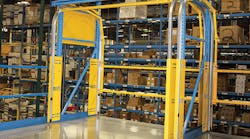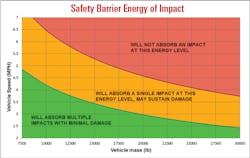As companies look to save costs and maximize space within their facilities, many are looking upward instead of outward. Elevated work platforms and multi-level racking systems are often a less expensive option—and sometimes the only option—to create additional storage space and work areas.
Multi-level work environments allow companies to add productive floor space without adding to their facility's footprint, which is generally less costly and time-consuming than expanding outward, leasing new space, or constructing a new facility. However, these elevated environments also create safety challenges that must be addressed.
Why Mezzanines?
When manufacturers increase throughput and build inventory, running short of storage or work space isn't a "good" problem—it's a problem, period. Fortunately, there are lots of options that facility managers can consider when addressing it.
Building a brand new, state-of-the-art warehouse with double or triple the storage might be one option, but in many cases it is cost-prohibitive. Renting out space from other facilities is another potential option, but that can also be costly and inconvenient.
Often, the initial consideration is to expand the current facility outward. Unfortunately, that's not always possible either, due to adjacent businesses land-locking the building footprint. This problem is particularly acute in densely populated areas such as in London, England, where industrial land use has decreased by nearly 16% since 2001, although the population and the number of retail buildings have simultaneously increased. This squeeze on industrial areas is also happening in the United States, and has led many companies to counter their lack of land space by adding air space.
Generally speaking, mezzanines cost less to construct than building a new facility or adding on to an existing one and provide the convenience of not having to move anywhere. They allow facilities to gain space without changing the footprint or address of their current operations.
Mezzanine Safety Challenges
Summarized in an annual report by the Occupational Safety and Health Administration (OSHA), falls are among the most commonly cited standard violations and the most common cause of serious work-related injuries and deaths.
Fatal falls, slips, or trips took the lives of 699 workers in 2013. Falls to a lower level accounted for 574 (82%) of those fatalities—with roughly one-fifth of those falls coming from more than 30 feet.
OSHA Regulations and ANSI Standards
While OSHA regulations are law and must be followed by employers and their workforce, many companies look to organizations like the American National Standards Institute (ANSI) for "best practices" guidelines to stay on top of the latest industry safety standards. Compliance with ANSI standards ensures that companies are implementing the most advanced safety standards in their respective industries.
In 2009, ANSI issued a standard titled, "Specification for the Design, Manufacture and Installation of Industrial Work Platforms" (MH28.3: 2009). This standard defines an industrial work platform as a prefabricated elevated platform (e.g., mezzanine) located in an industrial environment, pre-designed using a steel framing system. Flooring may include other structural or non-structural elements such as (but not limited to) concrete, steel, and/or engineered wood products. This new specification is intended to be applied to the design, manufacturing, installation and maintenance of such structures.
ANSI Standard 6.4.3 goes on to state that any gate providing access opening through the guards for the purpose of loading and unloading material onto a work platform shall be designed such that the elevated surface is protected by guards at all times. The key takeaway here is gates that swing open, slide open, or lift out leaving an unprotected opening in the guarding are not acceptable.
Elevated Platform Safety Solutions
Based on current standards, industrial mezzanines must have handrails and gates around all edges; however, these gates need to be opened from time-to-time to accommodate the loading and unloading process. According to the ANSI standard, companies must provide full-time protection when loading and unloading materials from an elevated platform—there can be no exposed areas where an employee could potentially fall. As a result, many companies are seeking a solution to secure elevated work environments.
Dual reciprocating barriers are becoming increasingly popular for this application, since they create a controlled access area in which the inner gate and outer gate cannot be opened at the same time.
Leading models use a link bar design that ensures both gates work in unison; when the outer gate opens to allow pallets in, the inner gate automatically closes to keep workers out. After the pallet is received, mezzanine-level workers open the inner gate to remove material from the work zone while the outer gate closes to secure the leading edge of the platform. A safety latch that can only be accessed when standing outside the work zone prevents the outer gate from being raised by a worker inside the work area.
Pick Module Safety
In addition to mezzanines and elevated work platforms, many companies are integrating multi-level pick modules within their facilities to handle order fulfillment. Pick modules are typically constructed using a metal support structure, flooring, stairways, handrails and landings. Products are stored in shelving and racks and are "picked" to conveyors, totes, carts and other transportation systems.
Multi-level rack systems pose a number of challenges when it comes to securing open areas during the loading and unloading process. The work areas are typically very small and are contained within the rack system itself, which makes it difficult to integrate traditional safety barrier designs.
Protecting Employees and the Bottom Line
Thanks to their cost-effectiveness and space-efficiency, elevated work areas such as pick modules and mezzanines are becoming increasingly common in industrial facilities across the United States. In order to provide the necessary safety for employees and to protect products, facility managers contemplating the addition of elevated workspaces must take OSHA-mandated safety regulations—and should take ANSI best practices guidelines—into consideration when designing and outfitting these areas. In both cases, dual reciprocating barriers can be a key element in safeguarding employees and ensuring regulatory compliance.
As growing businesses hope to utilize these hidden storage spaces even more, the biggest challenge appears to be mitigating potential fall hazards. But, with the right safety measures in place, the sky is the limit.
Andy Olson is marketing manager at Rite-Hite Corp. (www.ritehite.com), a manufacturer of loading dock safety systems, industrial door solutions and in-plant products.
-------------------
Several years ago, an international manufacturer of food services, sanitary maintenance, waste handling and material transport products was searching for a non-traditional barrier to protect workers from a fall hazard in its northern Virginia shipping facility.
The company ended up adding a state-of-the-art automated shipping facility to the plant to sort orders for customers worldwide. The 1,200-worker operation is supported by a 28-aisle automated storage and retrieval system (AS/RS) and new carton sortation conveyor system. The new conveyor system is directly integrated to the AS/RS with 56 case-pick stations designed for labor-efficient order fulfillment picking operations.
The new shipping center uses a unique design, with case-pick operations on an elevated mezzanine structure to maximize space from the picking side of the facility. However, it required a means of edge protection for a series of potential fall hazard points where the mezzanine interfaces with the AS/RS. In an effort to ensure a safe workplace, the company decided to install high-speed, high-cycle automated barrier doors.
Like a safety gate, the high-speed barrier option offered the necessary physical barrier to provide fall protection and keep someone from getting into the AS/RS area, as well as the ability to maintain visual attachment to the process. Furthermore, the doors' roll-up design minimized their footprint in a facility that was attempting to maximize its space.
The barrier doors were manufactured to the company's exact specifications and utilized quick-disconnect cables, which made them preferable to the other options from an installation and system integration standpoint.
Once installed, the automated barrier doors provided a seamless solution across the entirety of the facility's case-pick operations area. The doors are integrated with the controls of the new carton sortation system and are automatically operated through PLC logic, providing the highest degree of safety and operator efficiency.




